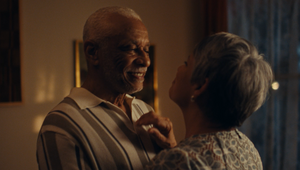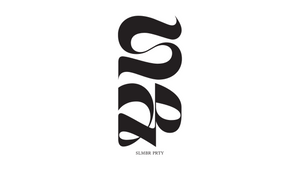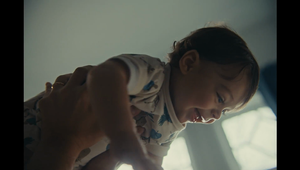
The Directors: Savannah O'Leary

Savannah is a director with a penchant for quirk, whimsy, and charm. She's known for her unique ability to capture a character's one-of-a-kind swagger.
Bred in Toronto and based in Brooklyn, Savannah arrived at directing through editing and still applies an editor's discerning eye to her work on set. Savannah loves to toy with an audience's expectations, whether heartfelt or bizarre, epic or bite-sized.
Her latest documentary short, Gone Viral, was acquired by The New Yorker Documentary and heralded for serving equal doses of poignancy and comedy. Her work has also been recognised by likes of DAZED Magazine, HuffPost, Short of The Week, 1.4 Awards, Vimeo Staff Picks, and the Webbys. Her commercial clients include Hageendaz, Huggies, Comcast, Robinhood, and more.
Name: Savannah O'Leary
Location: Brooklyn, New York
Repped by/in: USA by SLMBR PRTY
Awards:
1.4 Awards Longlist for Gone Viral
Vimeo Staff Pick for Gone Viral
Nitehawk Shorts Festival Audience Award for The Making of Panthera
NewFest Official Selection for The Making of Panthera
Vimeo Staff Pick for The Making of Panthera
Cinema Diverse Official Selection for The Making of Panthera
LBB> What elements of a script sets one apart from the other and what sort of scripts get you excited to shoot them?
Savannah> I love a novel point-of-entry to an otherwise ordinary product and when the proposed visuals are complementary rather than literal.
I also get excited by offbeat characters, and it's super fun when the boards at large take on the personality of the script. I'm thinking of the deck from one of my favourite spots last year (for Huggies) -- all of the contextual information ahead of the script was conveyed with such a strong personality, and it got me really inspired about the tone of the spot.
LBB> How do you approach creating a treatment for a spot?
Savannah> Usually, there's something really specific I'm excited about proposing - like a reference music track or a singular shot - and I like to flesh that out before I expand on everything else. If I don't force myself to write in order, the treatment is less daunting and more fun. I often finish the 'Look & Feel' or 'Music' section before I start a high-level 'Approach' page.
I avoid getting too fussy about the image pull until the final stages of refinement because I know that putting images in the context of a deck can change them completely. So once you've established an overall vibe with the treatment, it's easier to forgive what may not be perfect about a single image (like if it has the right framing but the wrong lighting.)
I also spend a lot of time in the Pinterest rabbit hole — once you've found a couple of good references, the algorithm is so good at showing you more.
LBB> If the script is for a brand that you're not familiar with/don't have a big affinity with or a market you're new to, how important is it for you to do research and understand that strategic and contextual side of the ad? If it's important to you, how do you do it?
Savannah> I have mixed feelings about this; unfamiliarity can be a good lens through which to evaluate the strength of a script because we should assume the audience doesn't know much about the product or campaign either. But I think proactive research is important, so the agency doesn't have to play too much catch up…it shows that you're serious about the job and helps you understand the creative's choices so you can keep iterating together.
LBB> For you, what is the most important working relationship for a director to have with another person in making an ad? And why?
Savannah> The DP is the obvious answer, but the line producer is equally important! They facilitate communication between the director and the creatives, which is the foundation for the project's success.
LBB> What type of work are you most passionate about - is there a particular genre or subject matter or style you are most drawn to?
Savannah> I gravitate towards character-driven creative with an opportunity to capture individual panache. Two of my favorite campaigns are Sara Dunlop's series for Facebook India and Zach Heinzerling's work for Smirnoff – the casting in both is so fun.
LBB> What misconception about you or your work do you most often encounter and why is it wrong?
Savannah> When my work features non-actors, I love to break the fourth wall and emphasise their glorious, idiosyncratic realness. People often assume that these 'candid' moments are born from happy accidents, but I like to treat them with intention and plan for them in the schedule. For example, the first few comedic beats of Ken Bone's interview in Gone Viral were all choreographed. He had made a fuss about wearing the iconic red sweater on a prep call we'd had, and it was such a meaningful conversation that I knew we needed to recreate it on camera. We did enough takes until we had material that felt candid. The cat stuff was also choreographed, and I'm forever grateful to his pets for cooperating.
LBB> Have you ever worked with a cost consultant and if so how have your experiences been?
Savannah> Thankfully my EPs run the show with cost consultants!
LBB> What's the craziest problem you've come across in the course of a production – and how did you solve it?
Savannah> There were nine cats on the set of Gone Viral, and my producer had a cat allergy. I haven't encountered any catastrophes yet; just irony :)
LBB> How do you strike the balance between being open/collaborative with the agency and brand client while also protecting the idea?
Savannah> I think treatments are helpful beyond the bidding process; they become a north star you can point to in the thick of production. The more thorough the treatment, the more prepared you are to protect the initial vision.
But at the end of the day, a director's job is different on a commercial set than an independent one - you are there to share your perspective as variables inevitably change and to problem-solve as a collaborator. The agency and the director are allies. Sometimes it's helpful to step aside and let the creatives lead with their expertise as they've been working with the client for months. Other times it's helpful for you to offer your fresh perspective.
LBB> What are your thoughts on opening up the production world to a more diverse pool of talent? Are you open to mentoring and apprenticeships on set?
Savannah> Directors crave exposure to each other's creative process at every stage of their career. Speaking for myself, I'd love to spend more time on other people's sets - there really aren't opportunities to do that after film school - and I would welcome any aspiring filmmakers who wanted to join mine.
There are so many awesome grassroots initiatives that foster community - I'm thinking of Video Consortium, Variable, and the events SLMBR PRTY hosts - but I wish there were more formal initiatives focused on learning and mentorship on set.
LBB> How do you feel the pandemic is going to influence the way you work into the longer term? Have you picked up new habits that you feel will stick around for a long time?
Savannah> No habits that I hope last! My biggest gripe with pandemic-induced workflows is remote call backs. So much is lost on the interwebs. It's tough to get a nuanced read of someone's energy, their ticks, their eye-contact, and the quality of their voice….especially when it comes to non-actors.
LBB> Your work is now presented in so many different formats - to what extent do you keep each in mind while you're working (and, equally, to what degree is it possible to do so)?
Savannah> Visually speaking, the reality is that you can't optimise for three different aspect ratios. So I like to align with the creatives on what our priority is and be realistic about what the sacrifices will be for the secondary formats. I often find the production design gets squeezed the most, because what looks good in a 16x9 frame might look sparse in a 9x16 frame, and it's impossible to accommodate both.
When it comes to performance, though, you have to prioritize all formats equally. The shorter cuts for social are often what clients put the most ad spend behind, and a 15-second sound bite can’t always be isolated from a 60-second edit. It's a director's job to make sure the burden doesn't fall on the editor to 'find' the social cut.
LBB> What's your relationship with new technology and, if at all, how do you incorporate future-facing tech into your work (e.g. virtual production, interactive storytelling, AI/data-driven visuals etc)?
Savannah> I'm pretty awestruck by what's happening with AI image and video generation right now. I've been playing around with Midjourney, RunwayML, and Dall-E. So far, I've only been using it to tweak existing imagery to better communicate my ideas in a treatment, like if I want to change the wallpaper pattern to look more vintage in a production design reference or remove someone's jewelry in a styling reference. But I want to get better at generating new imagery based on look and feel references…then you could essentially storyboard your whole idea. Doing that well is clearly a skill; I haven't found the prompting process to be super intuitive yet. It's easy to generate a photo-realistic image of a dog on a paisley couch; it’s harder to apply the wide-angled lensing you're proposing, the precise lighting you're after, or the subtle blur inherent to a handheld approach.
LBB> Which pieces of work do you feel really show off what you do best – and why?
Savannah> My goal is always to serve up equal doses of charm and quirk, and I'm grateful to have worked with such an eclectic cast of vibrant characters. I hope I've done them justice!
Gone Viral
Real Grandmas. Real Reviews (Huggies)
Unlimited Possibilities (Comcast)
My Kind of Extra (Haagendaaz)















